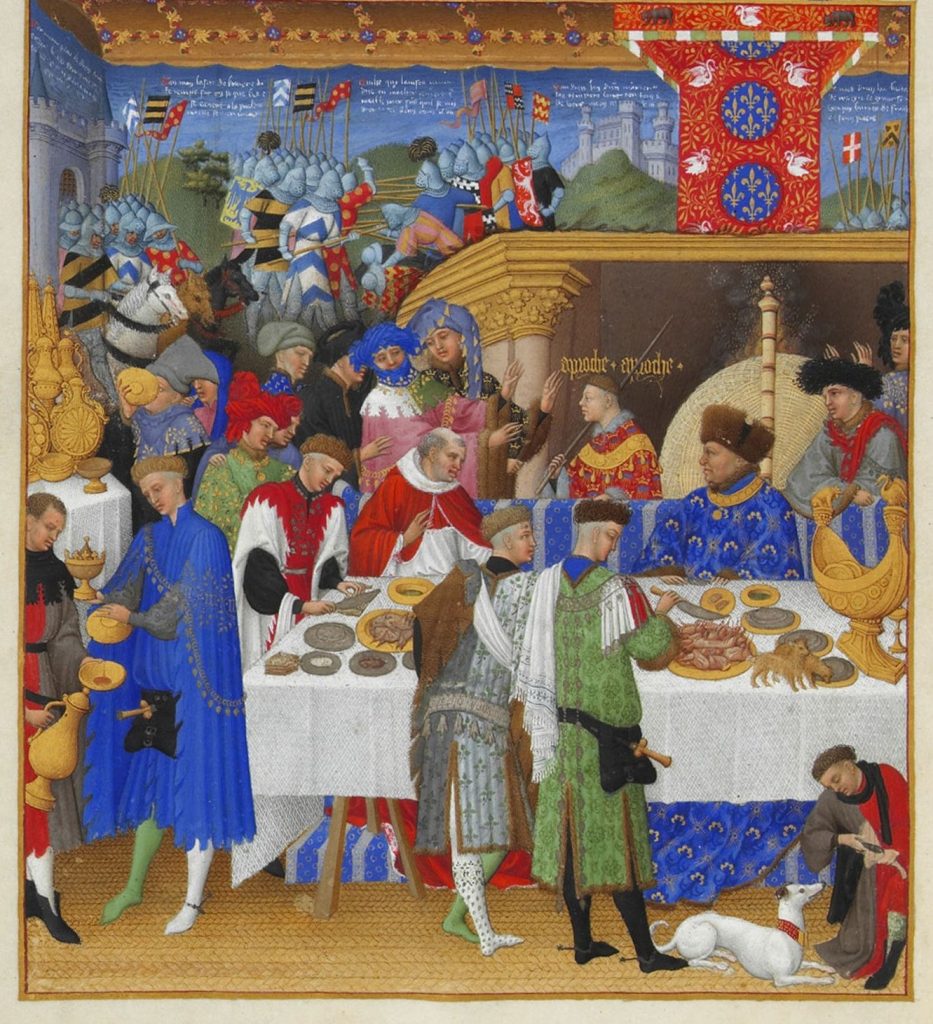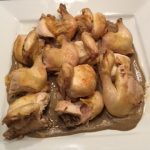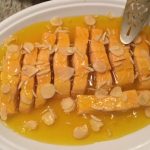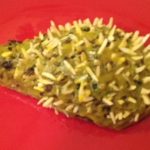
Les Tres Riches Heures du Duc de Berry, 15th century manuscript

Craytoun
For to make craytoun: Combine 6 or 8 chicken thighs, 3 cups whole milk, 2 teaspoons each ground ginger and cumin, and 1 teaspoon kosher salt in a heavy pot large enough to hold the chicken in one layer. Simmer, covered, until the chicken is very tender, turning it periodically, 1 to 1 1/2 hours. Remove the chicken, degrease the sauce, and reduce the sauce by about half. Combine the sauce in a blender with 1 slice (1 ounce) of bread, torn, the crust removed. Let stand a few minutes and then blend until smooth. Return the sauce to the pot and bring to a simmer. Taste and add more spices or salt if needed. Add the chicken and heat through. (If boiled, the sauce may separate, depending on how much it has been reduced.)

Pygges in sawse sawge
Sawse sawge: Blend to a smooth paste: 1 packed cup wet parsley leaves, about 3 TB sage leaves (unwashed and loosely packed), 1/2 slice (1/2 ounce) bread (torn in small pieces, with the crusts removed), 2 TB cider vinegar, and 3 hard-boiled egg yolks. Add salt to taste (about 1/2 teaspoon). This makes about 1/2 cup of sauce, enough for a large pork tenderloin. Garnish with the whites of the eggs.

Mouton with frumente
For to make frumenty: In a heavy pot, cover 8 oz. hulled wheat berries (wheat kernels) with water, topping them by 1 inch. Bring the water to a boil, remove the pot from heat, cover, and let the berries stand 8 to 12 hours at room temperature. Drain the berries and return to the pot. Cover the berries with (more or less) half salted chicken broth and half milk (or, better, almond milk; see directions under bruet sarcynesse). Set the pot over a flame-tame device, partially cover, and simmer gently until the berries are tender, about 2 hours, stirring often and topping up the liquid with more broth or milk if the berries become uncovered. Grind 0.15 ounces saffron threads with 1/2 teaspoon salt to a fine powder using a mortar and pestle. Add this to the berries, along with 2 or 3 egg yolks beaten with 1/2 cup milk. Heat just until the mixture thickens, stirring constantly. (If the liquid comes near the simmer, the egg yolks will curdle.) Taste and carefully adjust the salt. This is enough for 8 people.
Sawse Camelyne: 2/3 cup red wine vinegar, 1/2 c each currants and walnuts, 1/3 c toasted small bread cubes or bread crusts, 2 t cinnamon, 1 t ginger, 1/2 t cloves, 1 t kosher salt and 1 t pepper or long pepper. Thin with 1/3 cup water and vinegar, depending. This makes about 1 cup.

Smale checkones ibake with black sauce
Black Sauce: Bake 1/2 cup torn bread crust at 350 degrees until well browned but not burnt. Toss 3 chicken livers in vegetable oil and bake until thoroughly cooked and no longer pink. After roasting a large chicken (or 3 Cornish hens), deglaze the roasting pan with 1 1/2 cups boiling water. Pour this liquid, including all fat, into a blender, add the bread crust, and let stand 2 minutes. Blend until smooth. Add the livers and their juices and blend until smooth. Turn this mixture into a saucepan and add 1/2 teaspoon each finely ground anise and grains of paradise (or, if you don’t have this, black pepper) and 1/4 teaspoon each ground ginger and cinnamon. Season the sauce with salt and about 1 teaspoon verjuice or vinegar. Bring the sauce to a simmer; thin with water if necessary. This makes about 2 cups sauce.

Bruet sarcynesse
Bruet sarcynesse: In a large skillet, fry 1 1/2 to 2 pounds of cubed beef chuck very brown in a quarter inch of oil, adding 1/2 cup small crustless bread cubes toward the end and frying the bread very brown as well. Drain the meat and bread and discard any oil left in the pan. Return the meat and bread to the pan, and then add 1/2 to 1 cup white or red wine plus enough water to cover the meat, along with 2 tablespoons sugar, 1/2 teaspoon ground cloves, and some salt. Cover and simmer the meat until tender, about 2 hours, adding more water if the sauce dries out. In the meantime, make almond milk as follows: Grind 1 cup blanched, slivered almonds in a blender, whirl with 2 cups boiling water, let stand 10 minutes or so, and then strain through a fine-mesh sieve, pressing hard on the solids with the back of a large spoon. Return the almond debris in the sieve to the blender, add another cup of boiling water, blend briefly, let stand a few minutes, and strain as before. You should now have about 1 pint of thick, creamy almond milk. (Discard the ground almonds.)* In a separate saucepan, simmer the almond milk with 2 teaspoons whole cubebs (substitute peppercorns if you don’t have this), 1 heaping teaspoon mace blades (or 1 teaspoon ground mace), and 1/2 teaspoon whole cloves until the milk tastes strongly of the spice, about 20 minutes, adding water if the mixture cooks down by more than a third. Boil off most of the liquid from the beef so that the fat begins to separate out, strain in the spiced almond milk, and simmer for 10 minutes to blend the flavors. Taste and adjust the seasoning, adding, in particular, salt. *NOTE: Many recipes for almond milk online call for cold water. Cold water does not work–or at least it does not extract the almond oil, which you definitely want. Almond flour can be substituted cup for cup for the slivered almonds, in which case you can simply steep the almonds and boiling water in a bowl for 10 minutes, without blending, and then strain. Do not use store-bought almond milk. It is only 2% almonds, and goodness knows what the other 98% is.

Gele of fyssh
Gele of fyssh: Remove the skin from 5 pounds salmon and cut in portions. Simmer gently for 10 minutes: 1 bottle of sweet German Riesling, one 17-oz. bottle of white wine vinegar, 2 teaspoons whole black peppercorns, and 0.15 g saffron threads ground in a mortar with 1/2 teaspoon salt. Arrange the salmon in a single layer in two or more pans and pour the bouillon over them. It will probably reach only halfway up the fish pieces, which is fine. Cover tightly and simmer over very low heat until the fish is done to your liking. Strain the bouillon through cheesecloth and, if necessary, top up with water to make 6 cups. Chill 1/2 cup of the bouillon and soften in it 2 packets plain gelatin (4 1/2 teaspoons). Combine this with another cup of the bouillon and heat until steaming hot over low heat, stirring, to dissolve the gelatin. Thoroughly stir this into the rest of the bouillon and chill it until thickened. Spoon this over the fish–in batches, if you are ambitious, letting each layer chill and solidify before adding another. This is enough for 8 to 10 people as a main course. If you are serving fewer, cut everything proportionately. Garnish the dish with paper-thin coins of ginger and raw slivered blanched almonds.

Tart de Bry
Tart de Bry: Shave the rind off 1 1/4 pounds Saint Nectaire, Camembert, or Brie, which should leave you with about 1 pound of cheese without rind. Cut the cheese in small chunks and process it to a smooth, thick cream with 4 large eggs (or 6 egg yolks), 2 tablespoons melted butter, 2 teaspoons sugar, 1 teaspoon ground ginger, and 1 teaspoon kosher salt. Smooth the mixture into a fully baked 9-inch tart shell. Bake the tart at 350 degrees until the filling is puffed across the entire top, 25 to 35 minutes. The tart can be reheated in a 200-degree oven for serving without suffering any harm, though it will not puff again. To suit (some) contemporary tastes, you may want to leave out the sugar and ginger and instead mix them together and pass them at the table for people to try. (The medieval English called this mixture powder douce.)

Blank maunger
Blank maunger: Poach 1 large bone-in, skin-on whole chicken breast (about 2 lbs.) in 5 cups well-salted water. In a heavy pot, simmer 1 cup Arborio or other short-grain rice in 2 cups of the chicken broth until the rice has absorbed most of the liquid, about 20 minutes. Grind 1 cup slivered blanched almonds in a blender,* then add the remaining cooking broth, first brought to a boil, and blend 1 minute at high speed. Let stand 10 minutes, then strain through a fine-mesh sieve, pressing the almonds hard with the back of a large spoon until dry before discarding. Add this almond milk to the rice. Place the rice over a flame-tame device and cook over very low heat until it is completely tender and is beginning to dissolve, at least 1 hour, adding 1 cup or more dairy milk if the rice becomes dry before it has sufficiently softened. Add 3 to 4 tablespoons sugar and plenty of salt—it’s the mild sweet-salt inflection that makes this dish. Remove and discard the chicken skin and bones, tear the chicken meat in strings, and stir it into the rice. Cook 15 minutes longer. Serve sprinkled with candied anise and slivered almonds fried in oil. This makes 4 to 5 cups, or 6 to 10 servings depending on what else is on the table. This is delicious! *NOTE: You can substitute a cup of almond flour for the almonds, in which case no blending is needed. See the almond milk note at bruet sarcynesse.

Yrchon
Farsur to make pomme dorryse and oþere þynges: Thoroughly combine (I use my hands) 1 1/2 pounds ground pork, 2 large eggs, 1/3 cup each currants and minced dates, 2 teaspoons ground ginger, 1 teaspoon each ground cloves, ground pepper, and fine-textured salt, and 1/2 teaspoon ground galingale (sold as laos powder or “galangal” in Thai import shops). Though not called for in the original recipe, you may want to add 1/2 cup dry bread crumbs or 1-minute rolled oats to soften the texture and retain moisture. Shape the mixture as a meatloaf and bake at 350 degrees to an internal temperature of 175 degrees, or shape as meatballs and bake or fry. To make a hedgehog, proceed as follows. Shape the beast on a parchment-lined sheet pan and bake until done. Let cool completely. Prepare the following batter: 2 large egg yolks, 3 tablespoons melted butter, 2 tablespoons flour, 1/4 teaspoon each sugar and salt, about 5 drops of liquid yellow food coloring (or a bit of ground saffron), and enough water to thin to a brushable consistency, probably about 1 1/2 teaspoons. Brush several coats of the batter onto the hedgehog, letting each one dry a bit before applying the next, and then stick your beast with slivered almond “quills” and currant facial features. Place the hedgehog in a 250-degree oven until the batter dries, about 20 minutes. Be careful not to let the gilding brown.

Dariolles in the pan
Dariols: This is how I would make these tarts the next time. In other words, this recipe has not been tested, so proceed at your own risk! For the pastry, combine in a food processor 1 1/2 cups all-purpose flour (measured by dip-and-sweep; 7 1/2 ounces weighed), 3 tablespoons sugar, 1/2 teaspoons fine-textured salt, and 10 tablespoons cold unsalted butter (cut in small pieces). Process until the butter disappears into the dry ingredients. Add 2 large egg yolks and pulse-process until the mixture gathers into a smooth ball. Divide the dough into 12 equal pieces and press into a well-buttered standard cupcake tin (1/3-cup capacity). Place in each tart shell 2 to 3 teaspoons minced dates and 3 or 4 pieces of strawberries cut the size of small raspberries. Bake the shells in a 350-degree oven until they are firm and browned and the strawberries have desiccated, about 25 minutes. Remove from the oven and let cool to tepid. In the meantime, grind a rounded 1/4 teaspoon saffron threads and 1 teaspoon sugar to a fine powder using a mortar and pestle. Warm 1 3/4 cups heavy cream with the saffron mixture and 1/4 c sugar until the color is vivid. Remove from heat. Lightly whisk together 2 large eggs and 2 egg yolks and then whisk this into the cream mixture. Fill the tepid shells with the tepid custard and bake at 350 degrees until the custard sets, 15 to 25 minutes. Let the tarts cool and firm a bit before removing them from the pan, but be sure to serve them warm.

Comadore
Comadore: Remove the stems for 8 ounces dried figs and cut them in quarters. Combine the figs and 4 ounces of raisins in a food process and pulse until finely chopped. Add 1 firm-ripe pear (I prefer Bosc), and 1 Granny Smith apple, both peeled, cored, and roughly chopped. Pulse-process everything almost to a paste. Turn the fruit mixture into a heavy pot or saucepan, add 1 cup white wine, and cook, covered, over very low heat until the paste is very soft, 30 minutes to 1 hour. Add 1/2 cup sugar, 1 teaspoon ground ginger, 1/2 teaspoon ground cinnamon, 1/4 teaspoon ground cloves, and 1/8 teaspoon ground galingale (see the forcemeat recipe above). Stirring constantly, cook over moderate heat until the liquid evaporates. In a medium skillet, preferably nonstick, fry 1 cup pine nuts in 2 TB oil until lightly browned. Add the nuts to the fruit mixture and cook, stirring, over moderate heat until the mixtures looks dry and wads into a ball. How you shape the paste depends on the wrappers you use. For our Morgan dinner, I used 12 egg roll skins, cut in half, to make 24 wrappers, but I think 24 wonton skins would yield a crisper result. Whichever one you choose, spread the paste on a piece of oiled foil in a rectangle that can be cut in 24 slim fingers that will fit inside the skins. Chill the paste thoroughly before cutting it. To form the fritters, lightly brush the edges of a wrapper with egg white. Place a finger of paste about 1/2 inch up from the bottom edge of the wrapper, fold the bottom over it, and then fold in the sides. You have now completely enclosed the paste. Roll up the enclosed paste in the rest of the wrapper and then pinch the edges with your fingers to seal. If possible, let the formed fritters stand at room temperature for 20 minutes to 1 hour before frying them. In a deep skillet or a pot, heat 3 pounds of solid vegetable shortening or lard to 350 degrees. (The original recipe says to fry in oil, and most people fry in oil these days, but oil makes for greasy fried foods. Solid fat is always better.) Fry the fritters in two or three batches until golden brown and crisp and drain them on paper towels. Serve them warm, not piping hot. These are particular favorites of mine.

Fretoure
Fretoure: In a large bowl, whisk until smooth 3 cups all-purpose flour, 2 1/2 cups beer, and 1 teaspoon each dry yeast and fine-textured salt. Cover the bowl and let the batter stand at room temperature for 1 1/2 to 2 hours. Gently stir the batter down and let it stand 15 minutes or so prior to frying. Peel and core 6 to 8 McIntosh or McIntosh-type soft apples–hard or crisp apples will not cook through. Cut the apples in 3/8-inch rings and toss the rings in flour until coated on all sides. Cover two sheet pans with cake racks and set the pans in an oven heated to around 200 degrees. Set the platter on which you plan to serve the fritters in the oven as well. In a deep skillet or a pot, heat 3 pounds of solid vegetable shortening or lard to 350 degrees. Transfer about 6 rings to the bowl of batter and stir them around until coated. Using a chop stick or tongs, transfer them to the hot fat and cook them until nicely browned, turning them once or twice. When they are done, transfer the fritters to the racks in the oven and fry more. Serve the fritters generously sprinkled with sugar. This recipe makes a lot of fritters. For a gathering of, say, six people, cut the recipe in half.

Ypocras & wafres with marchpane
Hippocras: Combine eight 3-inch cinnamon sticks, 4 large or 6 small whole nutmegs, 4 teaspoons whole cloves, and 7 whole peppercorns in a sturdy self-sealing bag (“freezer bag”) and whack with a rolling pine or small, heavy skillet until coarsely crushed. Stir the spices into 2 quarts of pleasant, neutral-tasting white wine (such as Pinot Grigio; Chardonnay type wines are too oaky), then add 1/3 cup coarsely chopped peeled ginger and 2 teaspoons dried rosemary. Cover and let steep for 24 hours (but no longer). Strain through a fine-mesh sieve, shaking the spice debris to salvage as much wine as possible. Pour 1 cup of the strained wine through a coffee filter. Change the filter, and then pour through another cup of wine. Repeat until all the wine is filtered. Mix the wine with 4 cups sugar and let stand until the sugar completely dissolves, which will take 30 minutes or longer. Serve cold. The wine will keep indefinitely in the refrigerator. About 2 1/2 quarts.
Wafers: If you bake these in a non-electric Swedish krumkake iron, you will get about 3 dozen extremely thin, delicate wafers. If you haven’t the patience for this (as I didn’t for our Morgan feast), you can use an electric waffle iron equipped with wafer and/or pizzelle plates, in which case you will end up with about 16 somewhat larger, thicker, crunchier (but nonetheless very nice) wafers. Whisk together 2/3 cup sugar, 1/2 cup all-purpose flour (measured by dip-and-sweep), and 1 1/2 teaspoons ground cinnamon. In a separate bowl, whisk until well combined 2/3 cup heavy cream, 3 large eggs, and 2 tablespoons rose water (preferably Middle Eastern). Pour the liquid ingredients over the dry and whisk the batter until smooth. Spoon as much of the batter into the iron as is needed to cover the plate and bake the wafer until brown and crisp. If the wafers soften upon keeping, warming them in a 200-degree oven for about 10 minutes will make them crisp again.
